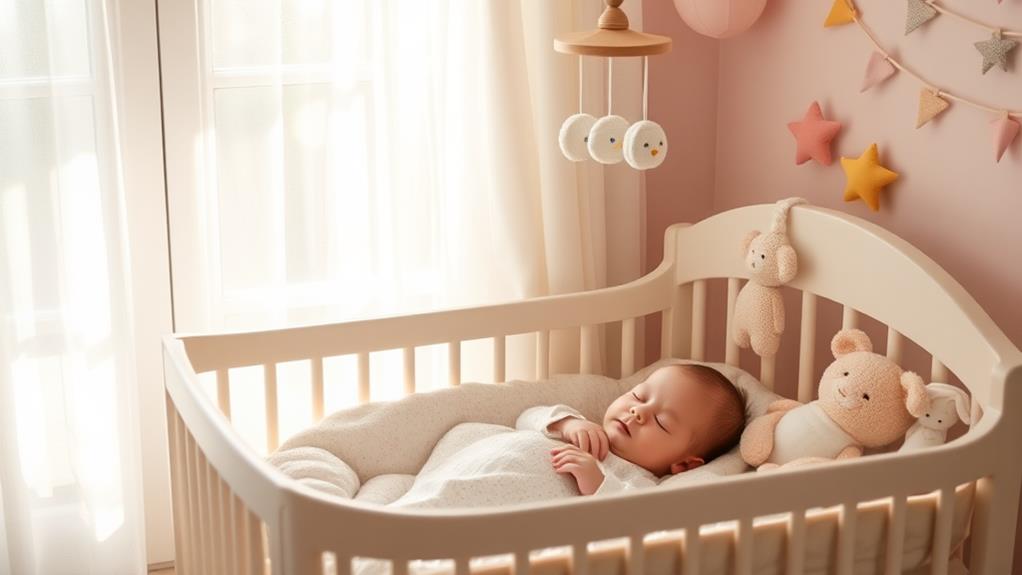Understanding your baby's sleep signals can significantly improve their rest and overall well-being. You might notice cues like yawning or eye rubbing, which often appear within a short window after they wake. Recognizing these signs early helps you avoid overtiredness, but it's not always easy to pinpoint them. Plus, establishing a consistent routine and environment plays a vital role in enhancing sleep quality. What are the other signs you should be aware of, and how can specific techniques further aid in achieving better sleep for your little one?
Recognizing Sleepy Cues

When it comes to helping your baby get the rest they need, recognizing sleepy cues is crucial. You might notice your little one yawning, rubbing their eyes, or staring blankly into space. These baby sleep cues are their way of telling you they're ready for some shut-eye.
Newborns typically show signs of tiredness after just 30 minutes to 1.5 hours of wakefulness, while older infants can usually handle a bit longer.
If you miss those early sleepy cues, your baby might become overtired, making it trickier for them to fall asleep. This can lead to increased fussiness, which no one wants!
It's important to remember that every baby is unique, so they may have their own special sleepy cues. Pay attention and take notes—yes, like a sleep detective!
Importance of Early Detection
How crucial is it to catch those sleepy cues early? Super important! When you spot those newborn cues—like yawning or eye rubbing—you can help avoid turning your little one into an overtired baby. Trust me, nobody wants that! An overtired baby can be more fussy and have a harder time settling down for sleep.
By recognizing sleepy signs promptly, you can align their naps with their natural wake windows, which are usually about 60-90 minutes for newborns. If you miss those cues, you might see a sudden burst of energy, and getting your baby to sleep will feel like a game of whack-a-mole!
Staying consistent in observing your baby's sleep patterns can improve the whole family's sleep quality. It creates a more peaceful sleep routine for you and your little one.
Plus, establishing a healthy sleep foundation through early detection not only helps now, but it also sets the stage for better long-term sleep habits, which is essential for their cognitive and physical development.
Common Newborn Sleep Signals
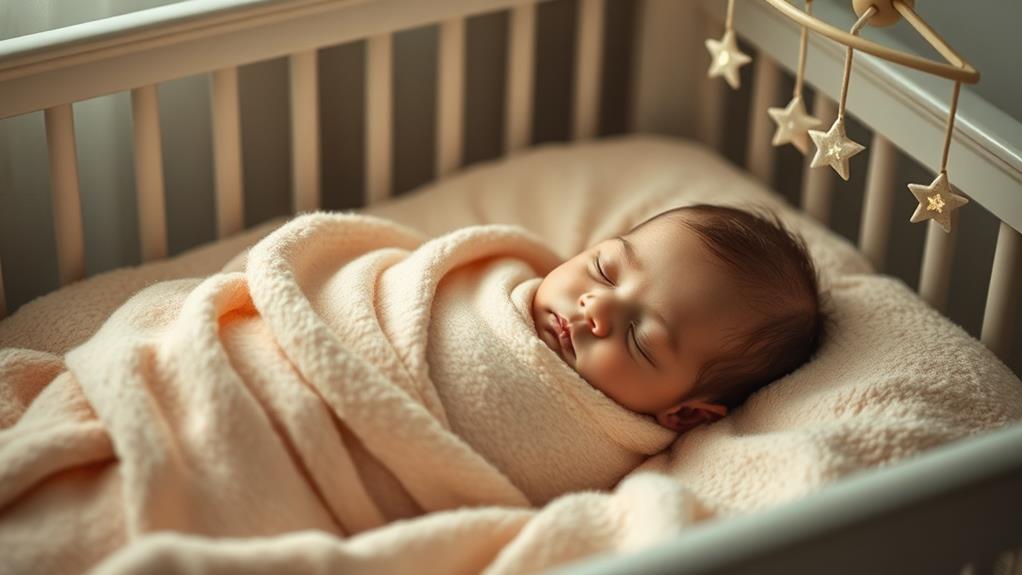
Catching those common newborn sleep signals early can make all the difference in your baby's sleep routine. Newborns often show their tiredness through yawning, eye rubbing, or turning away from stimulation. These cues usually pop up within 30 minutes to 1.5 hours after they wake up, so it's super important to pay attention during this time.
If you notice your little one staring blankly or losing interest in toys, it's a good sign they might need a nap soon.
You might also see them pulling at their ears or arching their back, which can indicate fatigue or discomfort.
Recognizing these newborn sleep signals not only helps your baby hit those important sleep milestones but also prevents them from becoming overtired and cranky.
Trust me, a well-rested baby means a happier home!
Baby and Toddler Sleep Indicators
As your baby grows into toddlerhood, you'll notice that their sleep indicators become more pronounced and varied. You might see them yawning, rubbing their eyes, or getting a bit fussier than usual. These sleep cues are your toddler's way of saying, "Hey, I'm tired!"
During the 3-18 months age range, you'll notice these signs change from more passive behaviors, like staring blankly, to active ones, including clinginess and crying.
It's crucial to pay attention to these cues, as toddlers have specific wake windows, usually lasting between 60 to 90 minutes. If you miss these windows, your little one can get overtired, making it even harder for them to settle down. And trust me, nobody wants a cranky toddler at bedtime!
Creating a calming pre-sleep environment can make a big difference. Consistent routines help reinforce positive sleep associations, so your toddler can transition to sleep more easily.
Timing Wake Windows
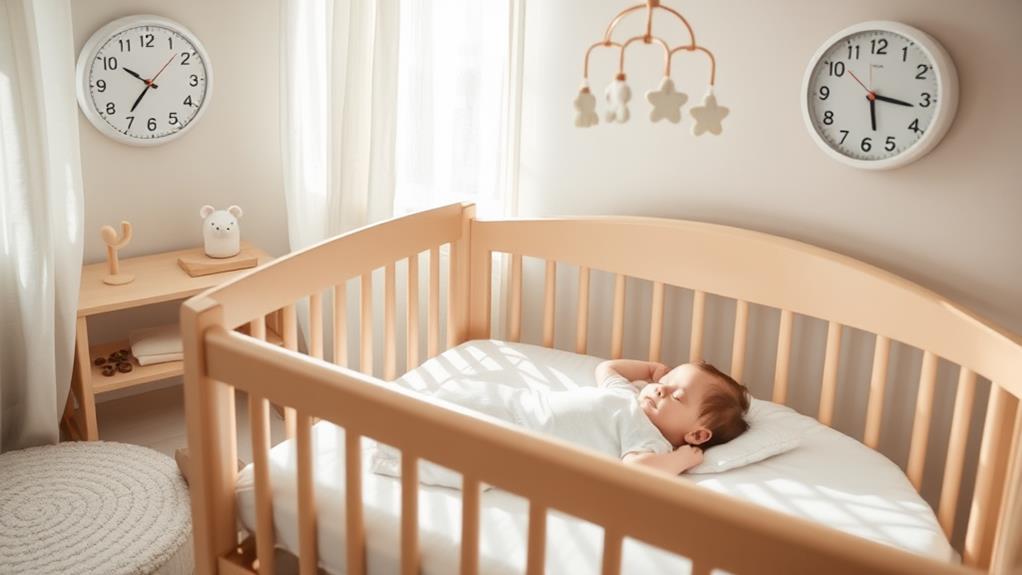
Understanding wake windows is essential for ensuring your baby gets the sleep they need. Every baby is different, but as a general rule, newborns can only stay awake for about 30 minutes to 1.5 hours before needing a nap. If your baby is tired, missing this window can lead to crankiness and a struggle to fall asleep.
As babies grow, their wake windows change. By 3-6 months, most babies need around 60-90 minutes of awake time before they need to snooze again.
Recognizing these ideal wake windows is crucial! If you notice your little one getting fussy or rubbing their eyes, it might be time to lay them down. Tracking your baby's wake windows can help you spot patterns and optimize nap times, boosting their overall sleep quality.
Just keep in mind that daily variations in mood and activity can affect these timings. So, be flexible! Sometimes, your baby might need a bit more or less awake time.
Creating a Sleep Routine
A consistent sleep routine is key to helping your baby settle down for the night. By establishing a regular bedtime, you're giving your little one a sense of predictability. Try incorporating calming activities like warm baths or reading a favorite story. These soothing moments signal to your baby that it's time to sleep.
Next, create a sleep-friendly environment. Keep the room dark and quiet, with a comfy temperature between 68-72°F. This helps promote optimal sleep conditions.
Don't forget to monitor your baby's sleep cues! Watch for signs of tiredness, like yawning or fussiness. Aim for about 1.5 to 2 hours of wakefulness for newborns before naptime to keep them from getting overtired.
To make things easier, consider tracking your baby's sleep schedule with tools like sleep logs or apps. This way, you can spot patterns and adjust the routine if needed.
Gradually implement a nightly routine with the same sequence of activities. Over time, your baby will learn what to expect, making bedtime smoother.
Managing Overtiredness
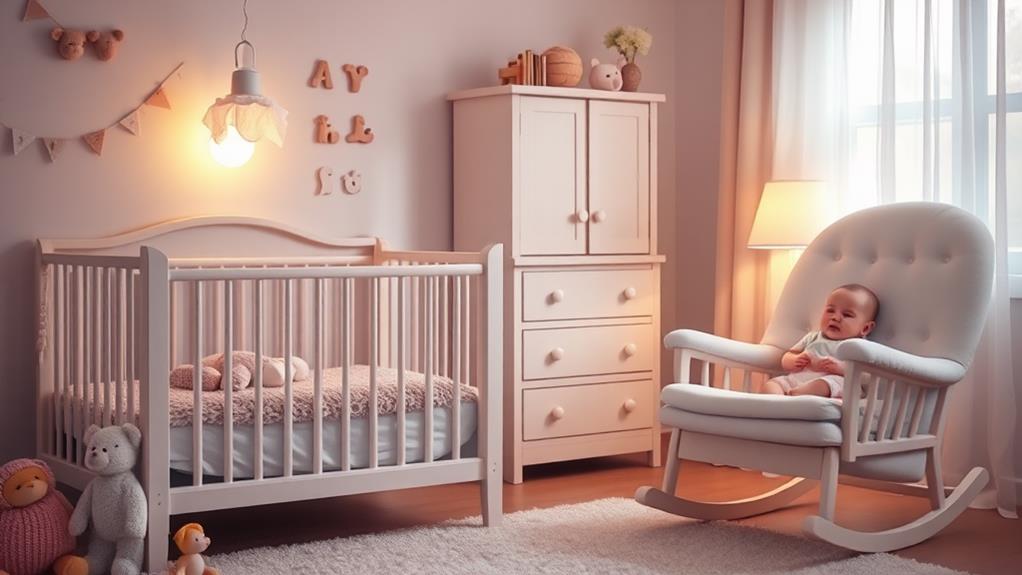
Managing overtiredness is crucial for your baby's sleep quality and overall well-being. When your baby becomes overtired, you might notice increased fussiness, difficulty falling asleep, and even shorter sleep durations. Those sleepy cues are essential signals that can help you catch the right moment for a nap. If you miss them, things can get a bit chaotic, especially during the late afternoon or evening when naps mightn't go as smoothly.
It's okay if you miss a cue now and then! Grace yourself; more opportunities for rest will come around. Staying calm and patient is key, as your little one can pick up on your energy.
Consider seeking guidance through sleep classes—these can give you effective strategies to manage and prevent overtiredness.
Establishing a healthy sleep foundation with a consistent routine will also help. The more you recognize those sleepy cues, the easier it'll be for both you and your baby to enjoy bedtime.
Adapting to Age Changes
As your baby grows, you'll notice that their sleep cues and needs change significantly. When they're newborns, you might see signs like yawning and eye rubbing. But as they get older, those cues can turn into clinginess or fussiness. Isn't it funny how that can feel like a mini tug-of-war?
Wake windows are important too! For newborns, these windows last about 30-90 minutes, but by the time they become toddlers, they can handle 2-3 hours of wakefulness.
By 6-12 months, many babies start sleeping longer at night, totaling around 12-15 hours, including naps. What a relief, right?
As they enter toddlerhood (ages 1-3), their sleep needs shift again. They require about 11-14 hours of sleep, usually including one nap.
So, it's essential to adapt to age changes in your baby's sleep patterns. This way, you can help them develop healthier sleep habits, which is a win-win for everyone involved!
Just remember, every baby is unique, and a little patience goes a long way. Happy snoozing!
Sleep Environment Essentials

Creating the right sleep environment is just as important as understanding your baby's evolving sleep cues. For your little one, especially during the newborn stage, a safe sleep setup is key.
Always place your baby on their back in a firm crib or bassinet. This simple habit can significantly reduce the risk of Sudden Infant Death Syndrome (SIDS), giving you peace of mind.
Temperature matters too! Keep the room cozy between 68-72°F to help your baby feel comfortable and avoid overheating.
When it's time for sleep, limit stimulation by using dim lighting and quiet voices. This helps your baby learn that nighttime is for restful slumber, not a party!
Consistency is vital in creating a healthy sleep routine. Try to use the same room and sleep setup for both naps and nighttime. This predictability makes it easier for your little one to settle down.
Oh, and a little tip: avoid co-sleeping! It can lead to risks like suffocation. Your baby deserves a safe space to dream sweetly, while you catch some Z's too!
Sleep Training Techniques
Sleep training is a crucial step in helping your baby develop healthy sleep habits. There are several sleep training techniques you can try, each with its own approach.
For instance, the Ferber Method focuses on gradually increasing the time before you comfort your crying baby. It teaches them to self-soothe, which can lead to better baby sleep in the long run. On the gentler side, the No Tears Method allows you to comfort your little one without letting them cry, offering a softer approach to sleep training.
Another option is the Chair Method, where you slowly move farther from the crib each night. This way, your baby can get used to falling asleep without you right there.
Then there's the Pick Up/Put Down Method, which involves picking your baby up when they cry and putting them down when calm. This helps them learn to settle down independently.
No matter which technique you choose, consistency is key. Sticking to a routine reinforces your baby's understanding of sleep expectations, making those nighttime battles a little easier.
Tools and Resources for Parents
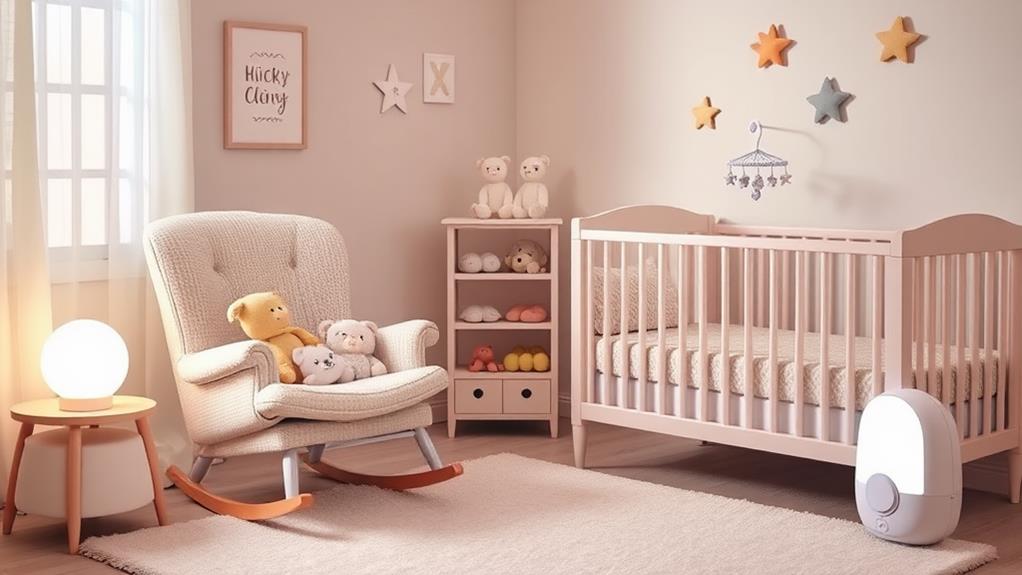
Finding the right tools and resources can make a significant difference in your journey to help your baby sleep better.
For starters, the Huckleberry App is a fantastic choice. It provides personalized sleep plans and helps you track your baby's sleep patterns. With this app, you can discover what works best when your baby moves during the night.
Advanced baby monitors, like the Nanit Pro Camera, can also be game-changers. They not only monitor your baby but also give insights into room conditions and personalized sleep reports. Plus, the Nanit Breathing Wear Sleeping Bags ensure your baby stays cozy and safe by regulating temperature.
If your little one struggles to settle down, check out the Nanit Sound + Light Machine. It creates a calming environment with soothing sounds and soft light, perfect for those restless nights.
Lastly, don't underestimate the power of community. Parenting blogs filled with expert-reviewed articles can provide valuable tips and encouragement.
Importance of Consistency
Establishing a consistent sleep routine is crucial for your baby's development and overall well-being. When you stick to regular sleep routines, you help your baby develop healthy sleep habits. This makes it easier for them to fall asleep, which means less fussing and more snoozing—what a win!
Creating a predictable bedtime and nap schedule can lead to improved sleep quality and longer sleep durations. Plus, keeping your baby's sleep environment consistent—like a cozy, quiet room—can minimize disturbances and promote better rest.
Before bed, follow a calming sequence of activities, like reading a story or giving them a warm bath. These gentle cues signal to your little one that it's time to wind down and drift off to dreamland.
Research shows that babies with consistent sleep practices are less likely to experience sleep disruptions and can avoid those dreaded overtired meltdowns.
Expert Tips for Better Sleep
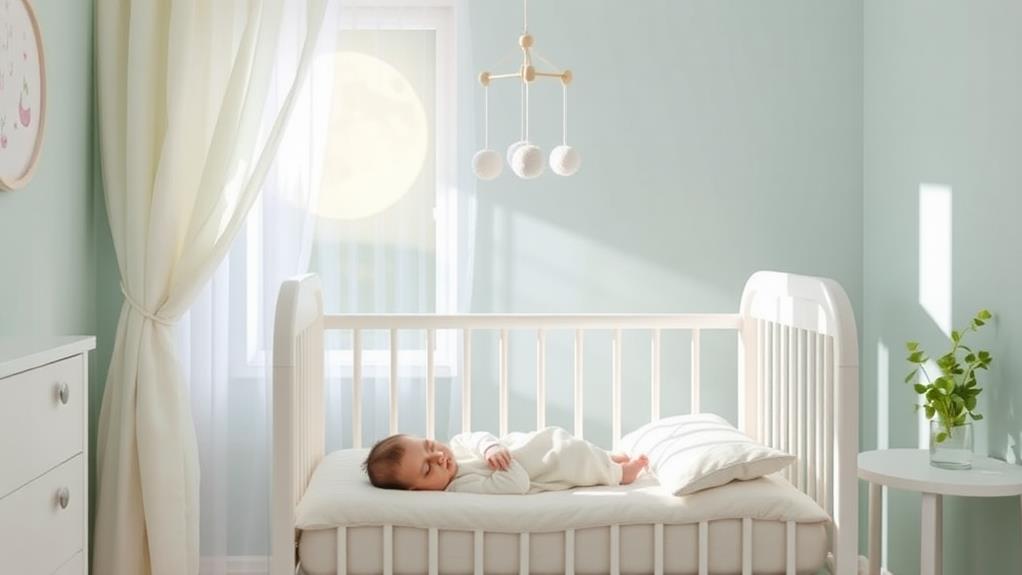
When it comes to helping your baby get better rest, a few expert tips can make a world of difference. First, establishing a consistent sleep routine is key. When your baby knows that bath time means bedtime, they'll start to associate those activities with sleep.
Next, keep an eye out for those early sleepy cues. If you notice yawning or your little one looking away, it's time to act! Catching these signs can help prevent overtiredness, which makes falling asleep easier.
Creating a sleep-friendly environment is also super important. Make sure the room is quiet and the temperature is just right—68 to 72°F is ideal. You might want to try some sleep training methods too, like the Ferber Method or the No Tears Method. These can help your baby learn to self-soothe and sleep independently.
Lastly, tracking your baby's sleep patterns using apps or journals can provide valuable insights. This way, you can tweak routines for even better sleep.

